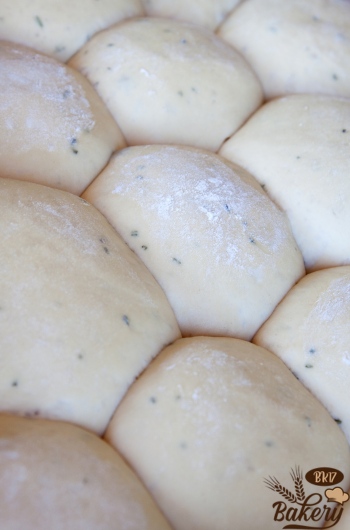Dough development is a critical part of any baking process, as the fermentation allows your bread to polish its texture and flavor.
Hence, it is natural to see home bakers freak out at sourdough not rising. Failure to treat the issue on time will throw all their efforts down the drain!
So why isn’t my sourdough rising? That was my question back in earlier days, too, but now I have the answer. Keep scrolling to learn more!
In This Article
Why Is My Bread Dough Not Rising?
Inactive levain, cold temperature, warm water, excessive salt/sugar/ dough fat, low-quality tap water, and old yeast are only a few among the numerous reasons why my sourdough doesn’t rise.

1. Inactive Levain
Sourdough refusing to rise might have something to do with your unripe starter.
I understand more than anyone else the excitement of parenting the first sourdough starter. Back then, I only wanted to start baking immediately after seeing the air bubbles form – which was a huge mistake!
Although the starter could still work under extra yeast, its active status cannot yet be guaranteed; you must feed it daily for about three to four weeks to get it ready.
And on another note, the feeding timing should also be properly calculated. Leaving the starter to collapse in between feeds paves the way for wrong enzyme and bacteria multiplication. Meanwhile, too-early feeding (before the peaks) keeps beneficial yeasts from expanding. So tread with caution!
2. Too Cold Environment
Starter activities are temperature dependent; hence, sourdough proofing below 77°F or 25°C might hamper its rise.
And the situation only gets worse when the temp drops below 59°F or 15°C; the chances of well-rising sourdough are almost non-existent at this point!
Always use proofers and place the dough in warmer spots to prevent disasters.
3. Too Warm Water That Destroys The Starter
And trust me, I am speaking from experience. A few times mixing my starter with hot water (above 155°F or 68°C) has taught me what it felt like to see my baby cake starter get mercilessly killed.
From then on, I always use water at room temperature to make my bread and feed the starter! One note, though: for kitchens too warm, you might want to consider using chilled waters to keep the dough from rising too fast.
4. Excessive Salt
Anyone with basic Chemistry lessons should understand why. Salt traps the water supply with osmosis, slowing down all yeast activities and eventually destroying gas production/fermentation.
At this point, the bread would be plainly inedible. I have made this mistake more than once throughout my ten years of baking journey – and had to throw the entire dish away every time it happened.
5. Excessive Sugar
I love how bread leaves a subtly sweet aftertaste and used to think that adding sugar can elevate such a culinary bliss. Turns out that it’s another gate to disaster, though.
Similar to salt, sugar also diverts water through absorption – which slows down the yeast’s respiration ability and keeps your dough from developing.
But what if you still want to add sugar to the mix to sweeten its flavor? Then remember these tips to ensure this sugar inclusion does not affect dough rise:
- Use more starters than required.
- Only add sugar in the latter half of the development process (ex: amidst bulk fermenting or nearing the mixing end)
- Switch to liquified sugar – which is easier to add and incorporate.
6. Excessive Dough Fat
Contrary to popular belief, adding fats to dough starter is not the brightest idea in the world: it weakens the gluten links and makes them much less efficient in trapping air.
The dough will still rise if you are lucky – but even in those cases, its dense texture is sure to please absolutely nobody.
So what to do if you still want to add fats (without dampening the sourdough)? Then my advice is to add them midway through your cake’s first rise. By then, the gluten structures have had enough time to establish themselves for extra fat inclusion.
7. Unsuitable Water For Dough Making
At first, this sounds like a bad craftsman blaming his equipment when the products do not turn out how he wants them. But hold on; this issue is included in my list for a good reason!
Certain living regions suffer from low-quality tap water, which, in the long run, reduces sourdough’s enzymic activities.
The same applies to osmosis water filters or heavily chlorinated water. So if you still have to use them for your bread recipes due to a lack of resources, take extra precautionary steps to purify the water first.
8. Dough Getting Hard Midway Through Final Proofing
Beginners tend to leave the dough uncovered and accidentally dry it out sooner than intended. Moisture escapes the crust areas, forming a skin layer so heavy and thick that the dough struggles to push through them and rise!
In worse cases, big rips and even spring explodes are inevitable; brace yourself.
9. Old Yeast
Start the habit of checking your dry yeast packets at grocery stores from today. Some of these products are either too weak or too old for your recipes, costing you a lot of money for nothing.
And despite its extended lifespan of 4-6 months, instant yeast only performs best when used fresh after recent refrigeration.
As if that’s a lesson that most beginner bakers have to learn, I also disregarded that entirely, storing the yeast in refrigerators for months and reusing it again in future recipes. You guess what I ended up with, right? it would be a miracle if the dead yeast was still active.
Do not fall into the same mistakes. Always check the expiration date and active modes of a packet of yeast before journeying through the rest of your recipe.
10. You Forgot to Grease The Plastic Wrap or Bowl Before Rising
The reason sounds so simple it feels almost laughable – but it is a common issue I have observed in my beginner baking days.
During its development, a few piece of dough might cling to the plastic wrap and bowl – and get stuck there instead of raising. Be ahead of your game and grease them both before putting any ingredients inside!
How to Fix When My Sourdough Bread Isn’t Rising

Thankfully, the situation is not all hopeless. You can adopt these simple steps to save your baked goods:
- Increase the internal temp to create a moist, warm dough-proof environment.
- Put proof boxes inside the oven (another alternative: place your flat dough near a boiling water pan)
- When the yeast fails to activate, add some more yeast, then proof it in lukewarm water and a dash of sugar. Stop when there are foams.
- Knead more wheat flour if your dough feels under-kneaded or sticky.
How to Ensure The Dough Will Rise
Ensure its gradual and proper rise by testing the starter and temperature. Always use warm water (but not too warm, of course) and create a safe proofing box for the dough. You are good to go!

Testing The Starter
An active and vibrant sourdough starter should show signs of surface bubbles, spongy texture, and size doubles.
If desired, perform float tests: drop the dough in water to see whether it rises to the water’s top. “Yes” means it is ready for further usage!
Checking The Temperature
Cold temperatures equal longer rising times, while warm temps speed up your process. Most recipes and guidelines specify the required temperature clearly, so use them as your guideline.
Using Warm Water
Warm water temperature (about 80 to 90°F) is the best assistant for any wet dough riser during cold weather. Avoid using cold water or cold dry ingredients (refrigerated flour, for instance), as they might hinder fermentation time.
Creating Proofing Box
Have no budget for commercial proofing boxes? Then use your own ovens as alternatives! Switch to the lowest temp, turn the oven off, and put one oven thermometer inside for easier temperature monitoring.
Can I Still Use Yeast Dough That Did Not Rise?
Fortunately, yes. Though the loaf of bread does not truly live up to expectations, it is edible and still enjoyable in numerous other ways. Do not just throw away the entire batch!
A case in point is to turn these non-risen doughs into delicious quick breads, flatbreads, or desserts. Drip them with butter or sugar, then sprinkle a few sesame seeds atop of them before baking.
To seal the deal, decorate the treats with filling and topping options of your choice. And there you have it – a repurposed dough with tasty flavors!
How Long Is Too Long to Let Dough Rise?

A dough should sit on your counter for 4 hours (yeast-made loaves) and 6 hours (sourdough). Of course, sugar characteristics, yeast amount, room humidity, and ambient temperature might or might not alter the numbers, but these are the most common estimations.
Conclusion
A non-rising dough is the last thing we want to happen to our bread, but no worries. Even in the worst-case scenarios, it can still be repurposed into snacks or tasty desserts!
Keep in mind my extra tips to prevent dough issues in the future. If you need more help, just contact me through DM.







